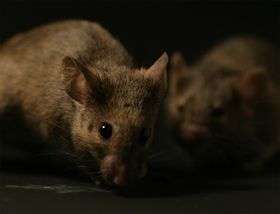Scientists reveal how mice recognise each other

Scientists at the University of Liverpool have discovered that mice rely on a special set of proteins to recognise each other.
Previous study assumed that another set of genes that influence smell in vertebrates might be used by animals that identify each other through scent. The team found, however, that mice use a highly specialised set of proteins in their urine to recognise different individuals, suggesting that this may also be true of other animals.
Professor Jane Hurst, Director of the Mammalian Behaviour and Evolution research group, explains: “For many years scientists assumed that a particular set of genes, called the major histocompatibility complex (MHC), helped animals to identify individuals within their own species through their scent. Each individual has a different MHC code, just like every human has a different fingerprint. It influences the body’s odour and it was assumed that animals that are sensitive to scents would use these different odours to recognise each other.
“We found, however, that whilst female wild mice do indeed use scent to identify individual males, MHC does not play a part. For example it is clear that we all have different fingerprints, but it certainly isn’t how we recognise individuals in everyday life. Equally, while MHC odours differ between individual mice, this isn’t the way they recognise one another.”
To test this theory, scientists observed how female mice identify potential mates. Female mice distinguish between dominant and weaker males, by how fresh a male scent-mark is. A dominant male is able to scent-mark a territory after excluding its other male competitors, allowing it to leave a more recent scent-mark than any of its competitors.
The group demonstrated that when faced with two males with different MHC types, females cannot identify which male left the fresh territory scents and which left the older scents, indicating that MHC differences are not sufficient for individual recognition as previously thought. Instead, they found that a special set of proteins in the urine of mice allows females to recognize which individual male is dominant.
Professor Hurst added: “These major urinary proteins (MUPs) act like a ‘chemical barcode’ of individual identity – each individual has a slightly different set of proteins, allowing each animal to be easily recognised. Our results demonstrate that this protein ‘barcode’ allows females to identify individual males accurately, and thus recognise dominant males that are likely to be good sires for their offspring.”
The research is published in Current Biology.
Reference: Cheetham, S.A., Thom, M.D., Jury, F., Ollier, W.E.R., Beynon, R.J. & Hurst, J. L. (2007); The genetic basis of individual recognition signals in the mouse. Current Biology 17: 1771-1777.
Source: University of Liverpool















